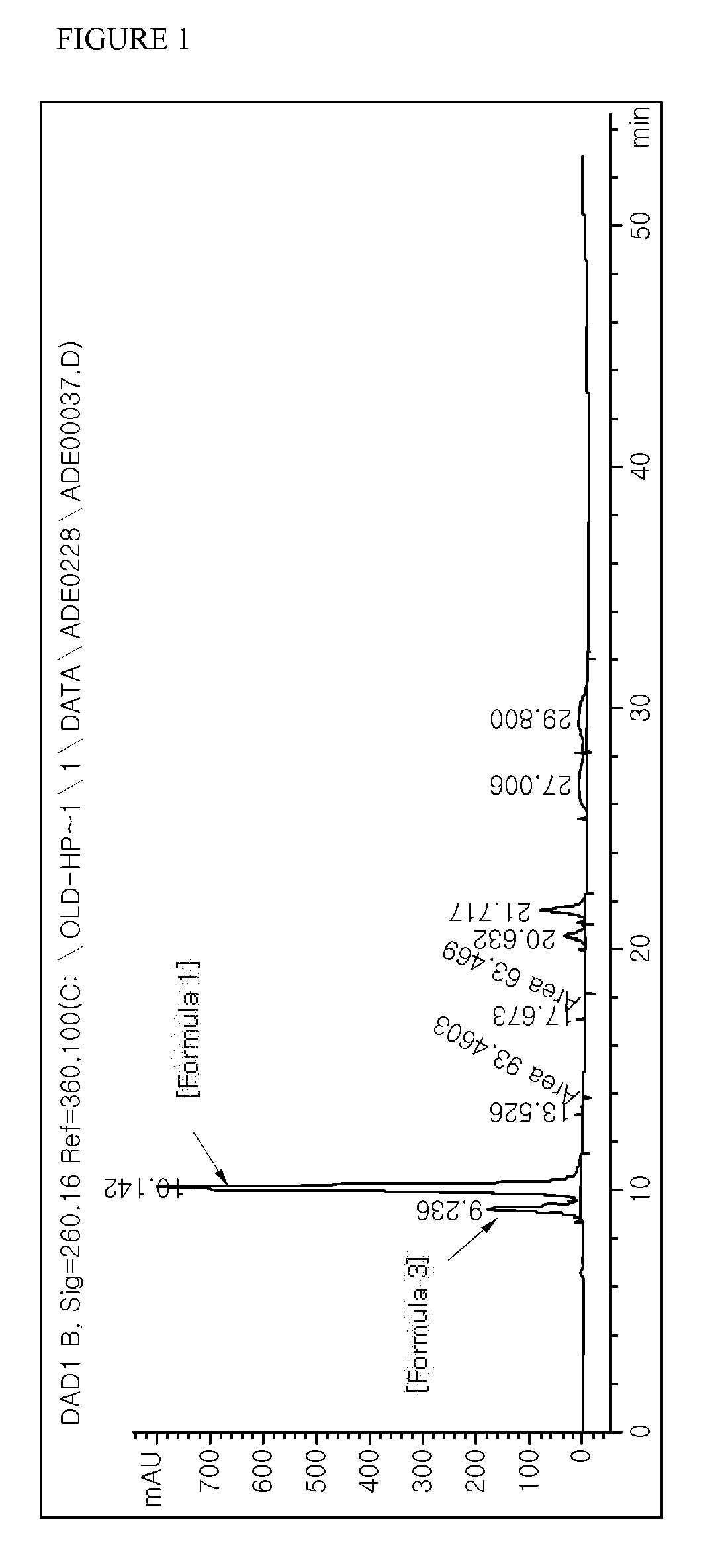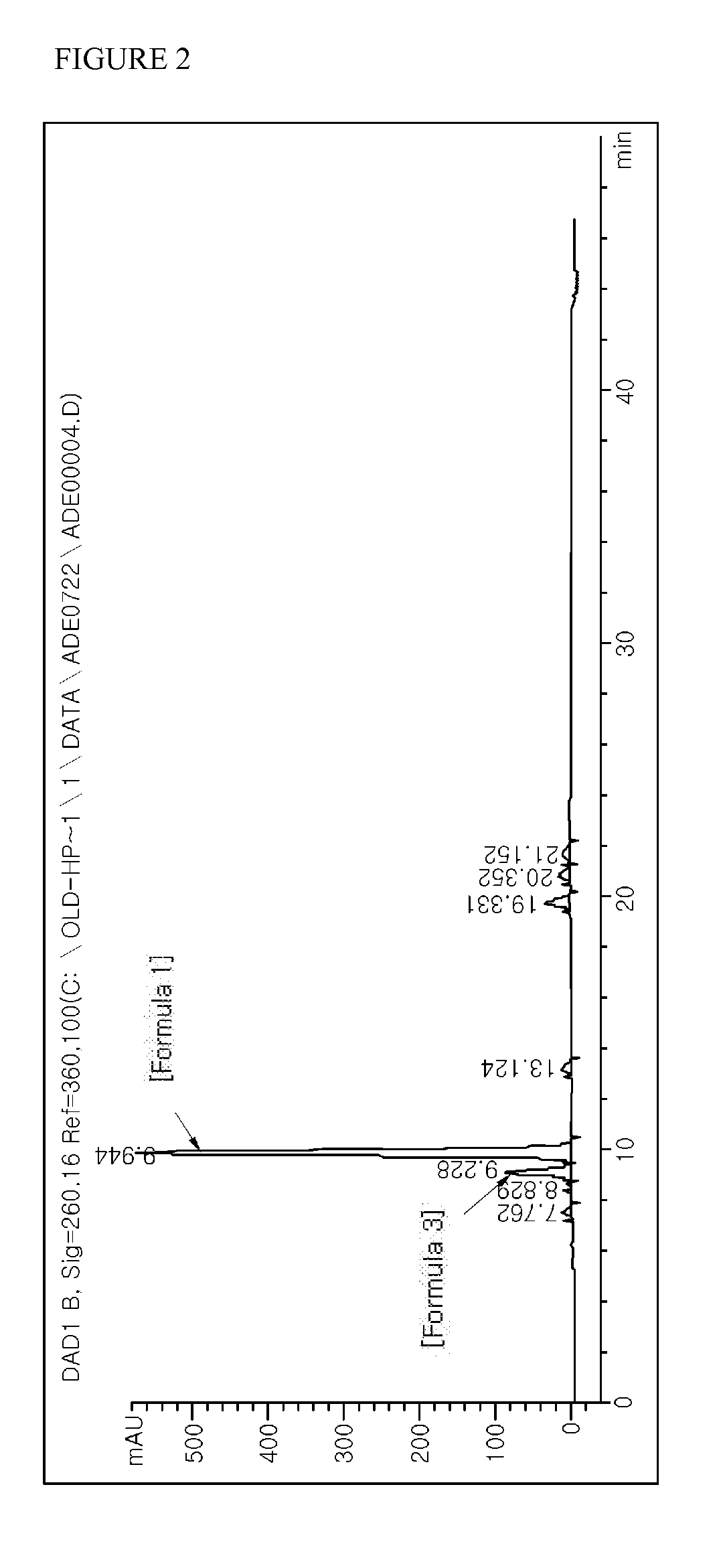Improved production method for adefovir dipivoxil
- Summary
- Abstract
- Description
- Claims
- Application Information
AI Technical Summary
Benefits of technology
Problems solved by technology
Method used
Image
Examples
example 1
Preparation method of adefovir dipivoxil, 9-[2-[[bis{(pivaloyloxy)-methoxy}phosphinyl]methoxy]ethyl]adenine, represented by Formula 1
100 g of 9-[2-(Phosphonomethoxy)ethyl]adenine (“adefovir”) and 400 g of dimethylsulfoxide were inputted into a reactor. Thereafter, 140 mg of triethylamine and 250 g of chloromethylpivalate were subsequently added thereto, and then, the mixture was heated to a reaction temperature of 40° C. and stirred for 5 hours.
After the mixture was cooled down to a temperature of 10 to 20° C., 500 ml of dichloromethane and 1000 ml of distilled water were added thereto, followed by stirring for 5 minutes. As a result, an organic layer was separated.
The obtained synthetic product was analyzed through HPLC. HPLC analysis was carried out by using an Alltech Mixed Mode Exchange™ C8 (7 u, 100 Å) as a column and a UV spectrophotometer (observed at a wavelength of 260 nm) was used as a detector, under conditions of a flow rate of 1.2 ml / min and a column temperature of room...
example 2
Preparation method of adefovir dipivoxil, 9-[2-[[bis{(pivaloyloxy)-methoxy}phosphinyl]methoxy]ethyl]adenine, represented by Formula 1
100 g of 9-[2-(Phosphonomethoxy)ethyl]adenine (“adefovir”) and 400 g of dimethylsulfoxide were inputted into a reactor. Thereafter, 140 mg of triethylamine and 250 g of chloromethylpivalate were subsequently added thereto, and then, the mixture was heated to a reaction temperature of 43° C. and stirred for 4 hours.
After the mixture was cooled down to a temperature of 10 to 20° C., 500 ml of dichloromethane and 1000 ml of distilled water were added thereto, followed by stirring for 5 minutes. As a result, an organic layer was separated.
The obtained synthetic product was analyzed through HPLC. HPLC analysis was carried out under the same conditions as described in Example 1. The results of analyzing the synthetic product obtained in Example 2 with HPLC are shown in FIG. 2 (in case of adefovir dipivoxil of Formula 1, RetTime (min): 9.944, Width (min): 0.2...
example 3
Preparation method of adefovir dipivoxil, 9-[2-[[bis{(pivaloyloxy)-methoxy}phosphinyl]methoxy]ethyl]adenine, represented by Formula 1
100 g of 9-[2-(Phosphonomethoxy)ethyl]adenine (“adefovir”) and 400 g of dimethylsulfoxide were inputted into a reactor. Thereafter, 140 mg of triethylamine and 250 g of chloromethylpivalate were subsequently added thereto, and then, the mixture was heated to a reaction temperature of 38° C. and stirred for 6 hours.
After the mixture was cooled down to a temperature of 10 to 20° C., 500 ml of dichloromethane and 1000 ml of distilled water were added thereto, followed by stirring for 5 minutes. As a result, an organic layer was separated.
The obtained synthetic product was analyzed through HPLC. HPLC analysis was carried out under the same conditions as described in Example 1. The results of analyzing the synthetic product obtained in Example 3 with HPLC are shown in FIG. 3 (in case of adefovir dipivoxil of Formula 1, RetTime (min): 11.518, Width (min): 0....
PUM
| Property | Measurement | Unit |
|---|---|---|
| Temperature | aaaaa | aaaaa |
| Fraction | aaaaa | aaaaa |
| Time | aaaaa | aaaaa |
Abstract
Description
Claims
Application Information
 Login to View More
Login to View More - R&D Engineer
- R&D Manager
- IP Professional
- Industry Leading Data Capabilities
- Powerful AI technology
- Patent DNA Extraction
Browse by: Latest US Patents, China's latest patents, Technical Efficacy Thesaurus, Application Domain, Technology Topic, Popular Technical Reports.
© 2024 PatSnap. All rights reserved.Legal|Privacy policy|Modern Slavery Act Transparency Statement|Sitemap|About US| Contact US: help@patsnap.com










